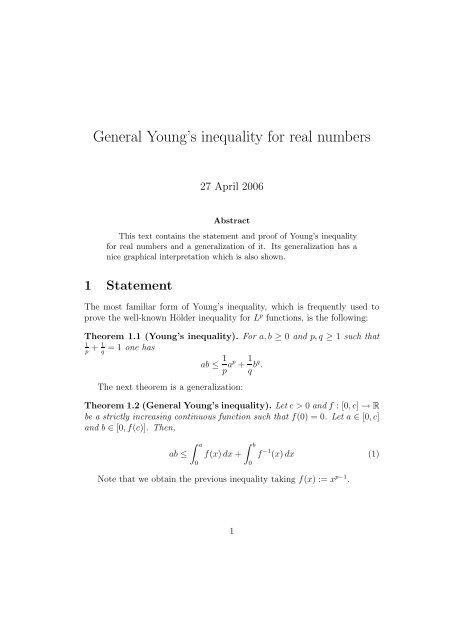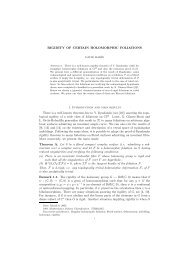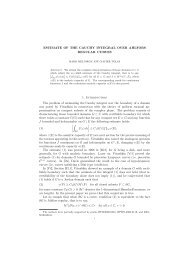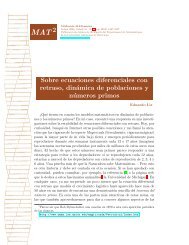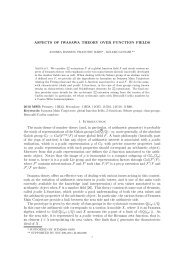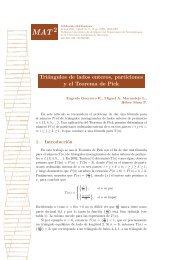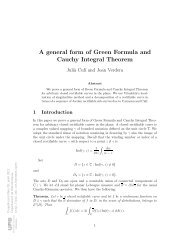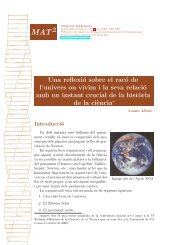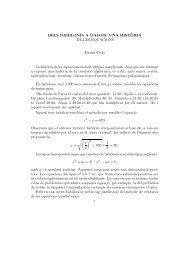General Young's inequality for real numbers
General Young's inequality for real numbers
General Young's inequality for real numbers
You also want an ePaper? Increase the reach of your titles
YUMPU automatically turns print PDFs into web optimized ePapers that Google loves.
<strong>General</strong> Young’s <strong>inequality</strong> <strong>for</strong> <strong>real</strong> <strong>numbers</strong><br />
27 April 2006<br />
Abstract<br />
This text contains the statement and proof of Young’s <strong>inequality</strong><br />
<strong>for</strong> <strong>real</strong> <strong>numbers</strong> and a generalization of it. Its generalization has a<br />
nice graphical interpretation which is also shown.<br />
1 Statement<br />
The most familiar <strong>for</strong>m of Young’s <strong>inequality</strong>, which is frequently used to<br />
prove the well-known Hölder <strong>inequality</strong> <strong>for</strong> L p functions, is the following:<br />
Theorem 1.1 (Young’s <strong>inequality</strong>). For a, b ≥ 0 and p, q ≥ 1 such that<br />
1<br />
p + 1 q = 1 one has ab ≤ 1 p ap + 1 q bq .<br />
The next theorem is a generalization:<br />
Theorem 1.2 (<strong>General</strong> Young’s <strong>inequality</strong>). Let c > 0 and f : [0, c] → R<br />
be a strictly increasing continuous function such that f(0) = 0. Let a ∈ [0, c]<br />
and b ∈ [0, f(c)]. Then,<br />
ab ≤<br />
∫ a<br />
0<br />
f(x) dx +<br />
∫ b<br />
0<br />
f −1 (x) dx (1)<br />
Note that we obtain the previous <strong>inequality</strong> taking f(x) := x p−1 .<br />
1
In these conditions, if we call<br />
Λ(x) :=<br />
Λ ∗ (x) :=<br />
∫ x<br />
0<br />
∫ x<br />
0<br />
f(y) dy<br />
f −1 (y) dy<br />
then another way to state the same result is to say that:<br />
ab ≤ Λ(a) + Λ ∗ (b).<br />
As Λ ∗ can be obtained from Λ, we can rewrite theorem 1.2 as follows:<br />
Theorem 1.3 (<strong>General</strong> Young’s <strong>inequality</strong>, second <strong>for</strong>m). Take c > 0<br />
and let Λ : [0, c] → R be C 1 and strictly convex with Λ(0) = Λ ′ (0) = 0. Then<br />
<strong>for</strong> any a ∈ [0, c] and b ∈ [0, Λ ′ (c)] it holds that<br />
where<br />
Λ ∗ (x) :=<br />
∫ x<br />
0<br />
ab ≤ Λ(a) + Λ ∗ (b) (2)<br />
(Λ ′ ) −1 (y) dy <strong>for</strong> x ∈ Λ([0, c]). (3)<br />
The following is a useful identity relating Λ and Λ ∗ :<br />
Lemma 1.4. Let c > 0 and Λ : [0, c] → R be a C 1 and strictly convex with<br />
Λ(0) = Λ ′ (0) = 0. Define Λ ∗ by (3). Then,<br />
xΛ ′ (x) = Λ(x) + Λ ∗ (Λ ′ (x)). (4)<br />
Remark 1.5. One can remove the requirement that Λ be strictly convex and<br />
still have the same results, but we will not do this here, as it involves some<br />
technical complications when defining the inverse function.<br />
2 Proofs and explanations<br />
For the proof of theorem 1.1 we just need the convexity of the exponential:<br />
Proof of theorem 1.1. The function x ↦→ e x is convex. This means that <strong>for</strong><br />
x, y ∈ R and 0 ≤ θ ≤ 1,<br />
exp(θx + (1 − θ)y) ≤ θ exp x + (1 − θ) exp y.<br />
2
When a or b are zero the <strong>inequality</strong> is trivial. Otherwise, the theorem is just<br />
this <strong>inequality</strong> with<br />
x := log a, y := log b, θ := 1 p .<br />
Theorem 1.2 can be understood with a picture (see figure 1). Recall that<br />
the inverse of a function can be drawn by reflecting its graph along the x = y<br />
line, so the area below the inverse of a function is the area to the left of the<br />
function (the area between its graph and the vertical axis).<br />
Figure 1: if f(a) ≤ b<br />
The following lemma, which we will use in the proof, can also be seen in<br />
the picture:<br />
Lemma 2.1. Let c > 0. For a strictly increasing continuous function f :<br />
[0, c] → R and b ∈ [0, f(c)] we have that<br />
bf −1 (b) =<br />
∫ b<br />
0<br />
f −1 (x) dx +<br />
∫ f −1 (b)<br />
0<br />
f(x) dx (5)<br />
(Note that this lemma is the identity in equation (4) when Λ is defined<br />
as Λ(x) := ∫ x<br />
0 f −1 (y) dy.)<br />
3
Figure 2: if f(a) ≥ b<br />
Proof. It is enough to prove it when f is C 1 , as then a continuous f can be<br />
uni<strong>for</strong>mly approximated by strictly increasing C 1 functions while f −1 is also<br />
uni<strong>for</strong>mly approximated. It is also enough to prove it when f(a) ≥ b, as<br />
otherwise we can just interchange both f,f −1 and a, b.<br />
To prove it in this case we can change variables in the integral ∫ b<br />
f −1 (x) dx<br />
0<br />
by putting x = f(y), and then integrate by parts:<br />
∫ b<br />
0<br />
f −1 (x) dx =<br />
∫ f −1 (b)<br />
0<br />
yf ′ (y) dy = bf −1 (b) −<br />
∫ f −1 (b)<br />
0<br />
f(x) dx.<br />
Proof of theorem 1.2. Use (5) and the fact that f is increasing:<br />
ab = bf −1 (b) + b(a − f −1 (b))<br />
=<br />
≤<br />
∫ b<br />
0<br />
∫ b<br />
f −1 (x) dx +<br />
f −1 (x) dx +<br />
0<br />
0<br />
∫ f −1 (b)<br />
0<br />
∫ f −1 (b)<br />
f(x) dx + b(a − f −1 (b))<br />
f(x) dx +<br />
=<br />
∫ a<br />
f −1 (b)<br />
∫ b<br />
f(x) dx<br />
f −1 (x) dx +<br />
∫ a<br />
0<br />
0<br />
f(x) dx.<br />
4
The rest is an easy consequence of these results. Theorem 1.3 is a rewrite<br />
of 1.2 and as it was said be<strong>for</strong>e, the identity in equation (4) is just lemma<br />
2.1 when Λ is defined as Λ(x) := ∫ x<br />
0 f −1 (y) dy.<br />
3 About this text<br />
This document has been written by José Alfredo Cañizo. The figures are<br />
by an anonymous vector artist who prefers to remain in the shadows. For<br />
comments or suggestions write to ozarfreo@yahoo.com. The latest version<br />
should be at http://www.ugr.es/~ozarfreo/tex .<br />
You can use this work under the terms of the Creative Commons license<br />
which can be found at<br />
http://creativecommons.org/licenses/by-nc-sa/1.0/.<br />
3.1 History<br />
11 August 2005: First version.<br />
27 April 2006: Correction of some mistakes.<br />
5


